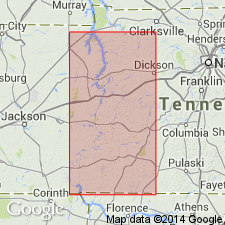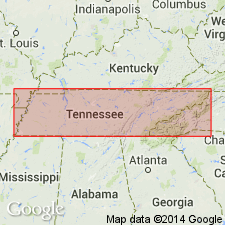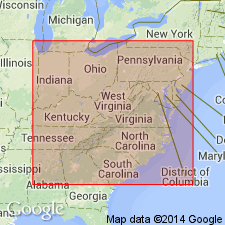
- Usage in publication:
-
- Harriman chert
- Modifications:
-
- Named
- Dominant lithology:
-
- Chert
- Novaculite
- AAPG geologic province:
-
- Cincinnati arch
Summary:
Harriman chert named in this report for creek in Decatur Co., western TN. Unit consists of very hard and brittle, nearly white novaculite. Weathers buff. Layers a few in. to over 1 ft thick. Thoroughly fractured. Thickness 0 to 55 ft. Is heavier bedded than unconformably overlying Camden chert (restricted). Unconformably overlies Quall limestone. Age is Early Devonian (Oriskanian).
Source: GNU records (USGS DDS-6; Reston GNULEX).

- Usage in publication:
-
- Harriman formation
- Modifications:
-
- Revised
- AAPG geologic province:
-
- Cincinnati arch
Summary:
Pg. 306-309, fig. 88. Harriman formation. Locally referred to as Harriman limestone or Harriman chert depending upon phase represented, used to include both Dunbar's "Harriman novaculite and Quall limestone." The Quall considered unweathered phase of the Harriman. Formation consists of two contemporaneous lithologic phases of limestone and chert. Thickness 37 to 55 feet. Unconformably overlies Flat Gap limestone where present; elsewhere unconformably overlies either [/]Ross limestone member or Birdsong shale member of [/]Ross formation (new). Unconformably underlies Chattanooga shale, or, as in Decatur and Benton Counties, Camden formation. Age is Early Devonian.
[Name Ross preempted by Ross Limestone of Foerste (1903), which = Ross limestone member of author. The application of an identical geographic name to a stratigraphic unit and its parts (Ross limestone member of Ross formation) conflicts with nomenclature guidelines (CSN, 1933; ACSN, 1961, 1970; NACSN, 1983, 2005, 2021). Precise duplication of geographic names of sedimentary units shall not be allowed, except as a most urgent necessity because of scarcity of available names or other conditions, and then only if geographic and stratigraphic separation is such as to preclude any possible chance of confusion (CSN, 1933).]
Source: Modified from US geologic names lexicon (USGS Bull. 1200, p. 1684).

- Usage in publication:
-
- Harriman Formation*
- Modifications:
-
- Overview
- AAPG geologic province:
-
- Cincinnati arch
Summary:
Name changed to Harriman Formation.
Source: GNU records (USGS DDS-6; Reston GNULEX).
For more information, please contact Nancy Stamm, Geologic Names Committee Secretary.
Asterisk (*) indicates published by U.S. Geological Survey authors.
"No current usage" (†) implies that a name has been abandoned or has fallen into disuse. Former usage and, if known, replacement name given in parentheses ( ).
Slash (/) indicates name conflicts with nomenclatural guidelines (CSN, 1933; ACSN, 1961, 1970; NACSN, 1983, 2005, 2021). May be explained within brackets ([ ]).

